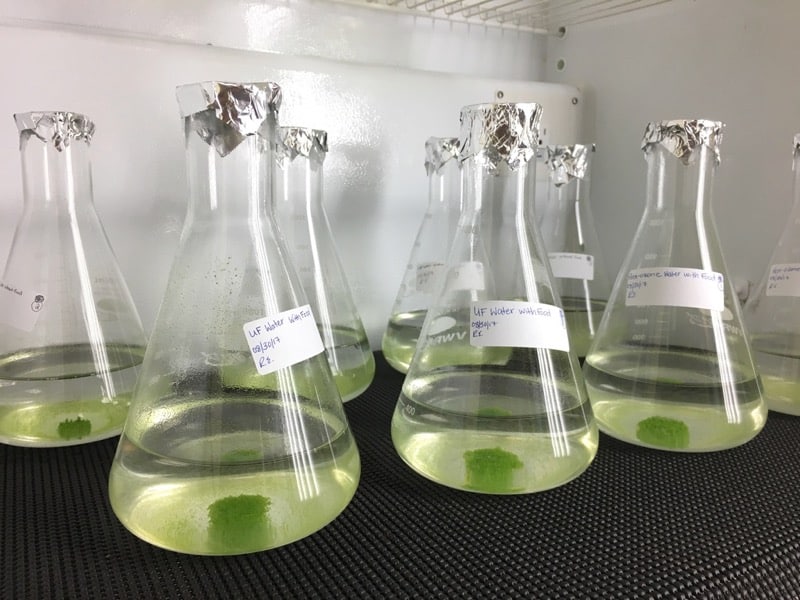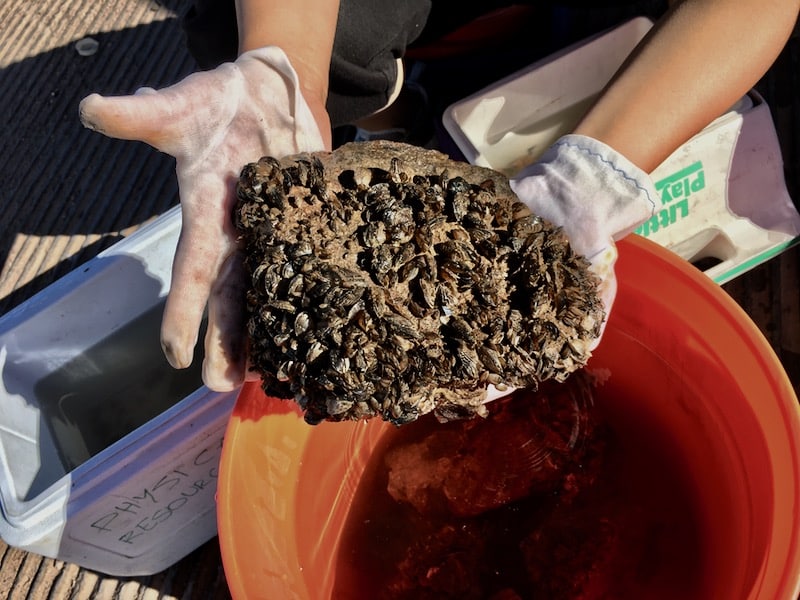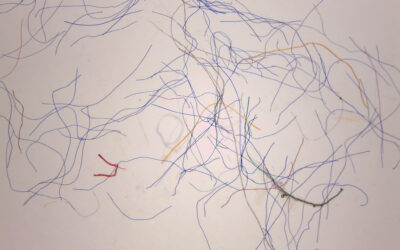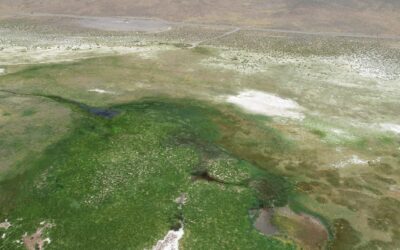Xuelian Bai, Ph.D., Assistant Research Professor of Environmental Sciences, works with an algae sample in the Environmental Engineering Laboratory at the Desert Research Institute in Las Vegas. Credit: Sachiko Sueki.
LAS VEGAS, Nev. (April 8, 2019) – A common species of freshwater green algae is capable of removing certain endocrine disrupting chemicals (EDCs) from wastewater, according to new research from the Desert Research Institute (DRI) in Las Vegas.
EDCs are natural hormones and can also be found in many plastics and pharmaceuticals. They are known to be harmful to wildlife, and to humans in large concentrations, resulting in negative health effects such as lowered fertility and increased incidence of certain cancers. They have been found in trace amounts (parts per trillion to parts per billion) in treated wastewater, and also have been detected in water samples collected from Lake Mead.
In a new study published in the journal Environmental Pollution, DRI researchers Xuelian Bai, Ph.D., and Kumud Acharya, Ph.D., explore the potential for use of a species of freshwater green algae called Nannochloris to remove EDCs from treated wastewater.
“This type of algae is very commonly found in any freshwater ecosystem around the world, but its potential for use in wastewater treatment hadn’t been studied extensively,” explained Bai, lead author and Assistant Research Professor of environmental sciences with the Division of Hydrologic Sciences at DRI. “We wanted to explore whether this species might be a good candidate for use in an algal pond or constructed wetland to help remove wastewater contaminants.”

Samples of Nannochloris grow in the Environmental Engineering Laboratory at DRI. This species of green algae was found to be capable of removing certain types of endocrine disrupting chemicals from treated wastewater. Credit: Xuelian Bai/DRI.
During a seven-day laboratory experiment, the researchers grew Nannochloris algal cultures in two types of treated wastewater effluents collected from the Clark County Water Reclamation District in Las Vegas, and measured changes in the concentration of seven common EDCs.
In wastewater samples that had been treated using an ultrafiltration technique, the researchers found that the algae grew rapidly and significantly improved the removal rate of three EDCs (17β-estradiol, 17α-ethinylestradiol and salicylic acid), with approximately 60 percent of each contaminant removed over the course of seven days. In wastewater that had been treated using ozonation, the algae did not grow as well and had no significant impact on EDC concentrations.
One of the EDCs examined in the study, triclosan, disappeared completely from the ultrafiltration water after seven days, and only 38 percent remained in the ozonation water after seven days – but this happened regardless of the presence of algae, and was attributed to breakdown by photolysis (exposure to light).
“Use of algae for removing heavy metals and other inorganic contaminants have been extensively studied in the past, but for removing organic pollutants has just started,” said Acharya, Interim Vice President for Research and Executive Director of Hydrologic Sciences at DRI. “Our research shows both some of the potential and also some of the limitations for using Nannochloris to remove EDCs from wastewater.”
Although these tests took place under laboratory conditions, a previous study by Bai and Acharya that published in November 2018 in the journal Environmental Science and Pollution Research examined the impacts of these same seven EDCs on quagga mussels (Dreissena bugensis) collected from Lake Mead. Their results showed that several of the EDCs (testosterone, bisphenol A, triclosan, and salicylic acid) were accumulating in the body tissues of the mussels.

Researcher examines a sample of quagga mussels collected from Lake Mead. A recent study by Bai and Acharya found that endocrine disrupting chemicals are accumulating in the body tissues of these mussels. Credit: Xuelian Bai.
“Algae sit at the base of the food web, thereby providing food for organisms in higher trophic levels such as quagga mussels and other zooplantkons,” Bai said. “Our study clearly shows that there is potential for these contaminants to biomagnify, or build up at higher levels of the food chain in the aquatic ecosystem.”
Bai is now working on a new study looking for antibiotic resistance in genes collected from the Las Vegas Wash, as well as a study of microplastics in the Las Vegas Wash and Lake Mead. Although Las Vegas’s treated wastewater meets Clean Water Act standards, Bai hopes that her research will draw public attention to the fact that treated wastewater is not 100 percent clean, and will also be helpful to utility managers as they develop new ways to remove untreated contaminants from wastewater prior to release.
“Most wastewater treatment plants are not designed to remove these unregulated contaminants in lower concentrations, but we know they may cause health effects to aquatic species and even humans, in large concentrations,” Bai said. “This is concerning in places where wastewater is recycled for use in agriculture or released back into drinking water sources.”
Bai’s research was funded by the Desert Research Institute Maki Endowment, the U.S. Geological Survey, and the Nevada Water Resources Research Institute. The studies mentioned in this release are available from Environmental Pollution and Environmental Science and Pollution Research journals:
Bai, X. and Kumud Acharya. 2019. Removal of seven endocrine disrupting chemicals (EDCs) from municipal wastewater effluents by a freshwater green alga. Environmental Pollution. 247: 534-540. Available: https://www.sciencedirect.com/science/article/pii/S0269749118347894
Bai, X. and Kumud Acharya. 2018. Uptake of endocrine-disrupting chemicals by quagga mussels (Dreissena bugensis) in an urban-impacted aquatic ecosystem. Environmental Science and Pollution Research. 26: 250-258. Available: https://link.springer.com/article/10.1007/s11356-018-3320-4
###
The Desert Research Institute (DRI) is a recognized world leader in basic and applied interdisciplinary research. Committed to scientific excellence and integrity, DRI faculty, students, and staff have developed scientific knowledge and innovative technologies in research projects around the globe. Since 1959, DRI’s research has advanced scientific knowledge, supported Nevada’s diversifying economy, provided science-based educational opportunities, and informed policy makers, business leaders, and community members. With campuses in Reno and Las Vegas, DRI serves as one of eight institutions in the Nevada System of Higher Education.


